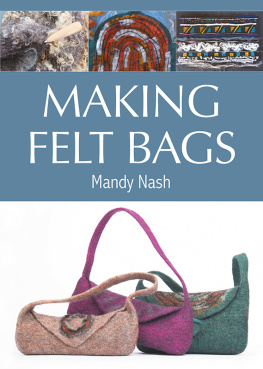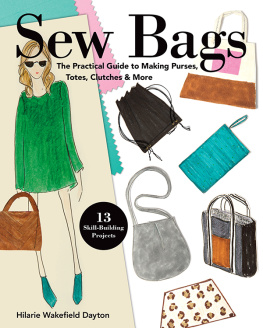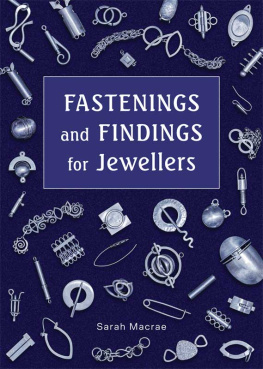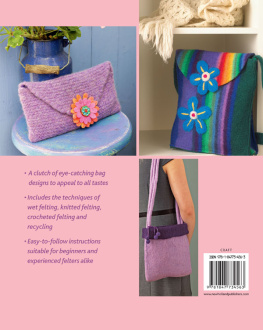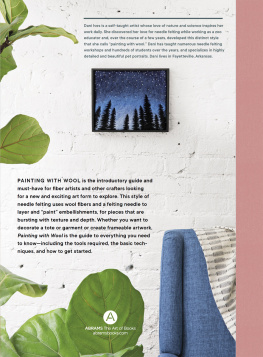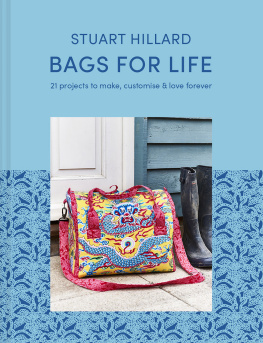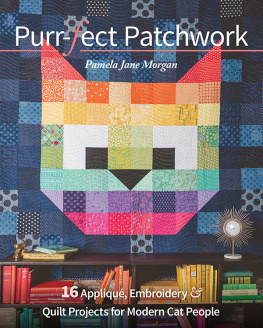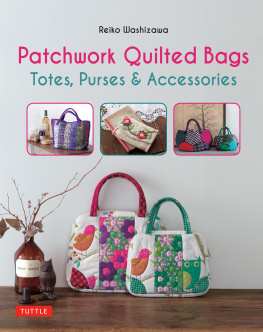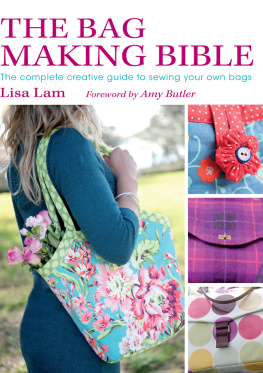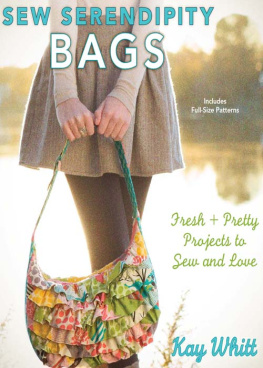Page List
MAKING
FELT BAGS
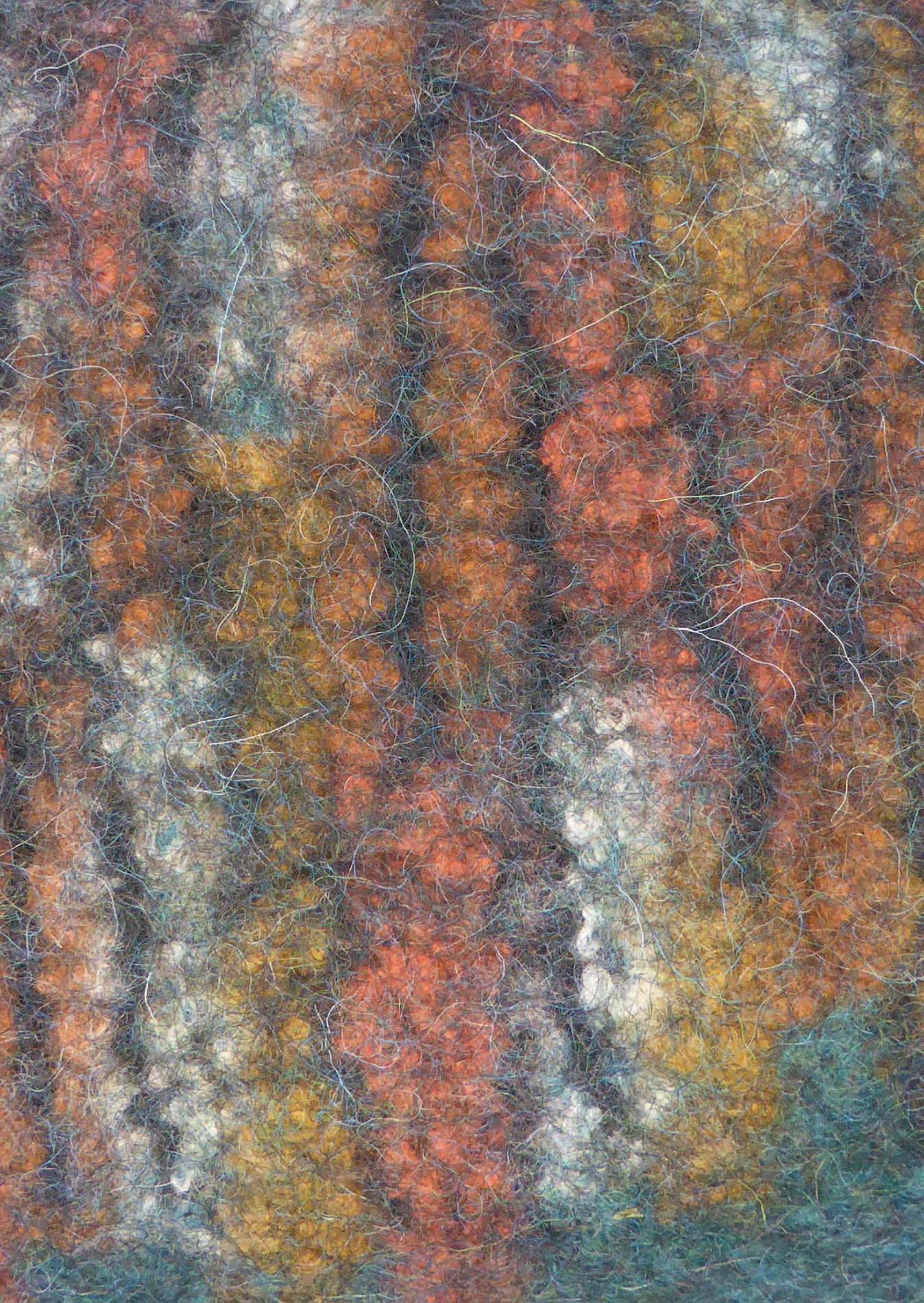
MAKING
FELT BAGS
Mandy Nash

First published in 2021 by
The Crowood Press Ltd
Ramsbury, Marlborough
Wiltshire SN8 2HR
www.crowood.com
This e-book first published in 2021
Mandy Nash 2021
All rights reserved. This e-book is copyright material and must not be copied, reproduced, transferred, distributed, leased, licensed or publicly performed or used in any way except as specifically permitted in writing by the publishers, as allowed under the terms and conditions under which it was purchased or as strictly permitted by applicable copyright law. Any unauthorised distribution or use of this text may be a direct infringement of the authors and publishers rights, and those responsible may be liable in law accordingly.
British Library Cataloguing-in-Publication Data
A catalogue record for this book is available from the British Library.
ISBN 978 1 78500 863 4
Acknowledgements
I have my grandmothers, Alice and Muriel, to thank for starting me off on my creative journey, passing on their traditional textile skills with boundless patience. My parents have to take some credit too, with their non-judgmental attitude towards my career choice and constant support and encouragement.
A special thank you must go to Heather Potten. An exceptional proof reader, she ensured that the content was understandable. Thanks too, to Eva Leslie, Jenny Rolfe and Jackie Stringer for double checking the text.
I must credit Heidi McEvoy-Swift for inventing the shrinkage test sample in , which is such an invaluable teaching aid. Thank you to all the feltmakers, whose workshops I have attended over the years, who have been generous in passing on their knowledge; to my students too, who have encouraged me to develop my skills. A special mention must go to Jenny Pepper for helping me to understand how to use a resist and Heidi Greb for introducing me to using raw fleece.
The lovely photographs of the finished bags were taken by Kate Stuart
www.katestuartphotography.com
INTRODUCTION
I first encountered felt in the 1980s when I saw the work of Annie Sherburne. I bought one of her kits and made some interesting samples with an unknown variety of wool that was tricky to felt. I only slightly fell in love with the technique then, rolling with my feet in my mothers kitchen and not fully understanding the process but loving the result. Roll on almost twenty years. Kate Bosset, a friend who had recently discovered feltmaking at a convergence in New Zealand (and had sought tuition from Anne Belgrave on her return to the UK), reacquainted me with the craft, as I would love feltmaking. She was right. I bought some merino roving which sat in my studio for three months until I eventually struggled to interpret my scant notes, remember what she had taught me, and make some rather strange felt samples. I was hooked.

I trained as a jeweller and continue to make my living from making and selling jewellery. My work has been heavily influenced by both traditional and contemporary textiles.My three passions are colour, pattern and technique. I love making things and exploring the possibilities of different materials. I use non-traditional materials to make my jewellery, which is highly colourful and often incorporates either textiles or textile techniques. Feltmaking contrasts with and complements jewellery making so it is the perfect marriage I enjoy working in both crafts. My feltmaking journey has had to fit in with making a living from selling my jewellery, attending the occasional workshop to extend my meagre knowledge alongside endless sessions making samples, often unsuccessfully as my ambitions exceeded my skills. The act of feltmaking is slow but meditative and cannot be rushed. In contrast with the insular nature of making jewellery, it is a sociable activity; you can make felt with people. My journey continues, as there is so much to learn about felt and its unique properties.
I have often been asked for recommendations for a good book for a feltmaking beginner to buy. It is a difficult question to answer the longer I make felt, the more I realize what a diverse medium it is and there are constantly new developments. As finding one book to cover all of this is impossible, I refer to several books for technical reference and many more in a much broader area for inspiration. Each feltmaker works in a different way, and the way one works is also dependent on what one is making. There is never only one solution.
My aim for this book is to provide an all-round guide and instruction manual to making functional felt bags for all levels of experience. It covers the principles of using a resist to create three-dimensional forms, looks at the shapes and styles of bags to suit all occasions and works with a variety of wool breeds. Each step-by-step project expands on the earlier chapters to explain and explore the processes of design and making to produce bags fit for purpose. To fully understand these processes, read the whole book before you start. There is never an end as there is always something new to discover.
CHAPTER ONE
MATERIALS AND EQUIPMENT
Read this chapter before rushing to buy any wool or equipment. There is an immense amount of information to absorb initially, which will gradually become relevant once you start to make felt. If you understand the materials you are working with, your feltmaking journey will be speedier and your finished products more professional.

An assortment of wools.
WOOL: YOUR CHOSEN MATERIAL
Wool is a natural, sustainable resource with excellent thermal qualities and many uses. Felt is one of the earliest known textiles and is not necessarily made from wool it can be made from various animal hair fibres such as alpaca, mohair, cashmere, camel, rabbit and beaver. However, wool felts best without the aid of any harmful chemicals.
Animal fibres felt together as their surface is covered in scales, smooth one way and rough the other. When moisture, heat and friction are applied, the scales soften, open up and link together to form a strong and versatile fabric. There are many varieties of sheep and their wool quality varies from thick and coarse for hardy sheep living in harsh climates to fine and soft such as merino that can survive in hotter weather. The length of the fibres (staple), the hardness of the scales on the fibres plus the crimp (curl) affect the ability of the wool to felt. Usually, wools with a long staple and good crimp felt well.
When I first discovered feltmaking, I had not realized that there were so many varieties of sheep, each with a delightful, fluffy wrapper. The wool of each breed of sheep has its own distinct properties. Some breeds felt well and quickly; some more slowly and with more effort; and some not at all. The quality and feel of the felt produced also varies tremendously. Some sheep are bred for meat only and their fleece does not usually make good felt. However, in the interests of limiting waste, other uses are being sought, such as insulation and slug repellent.

